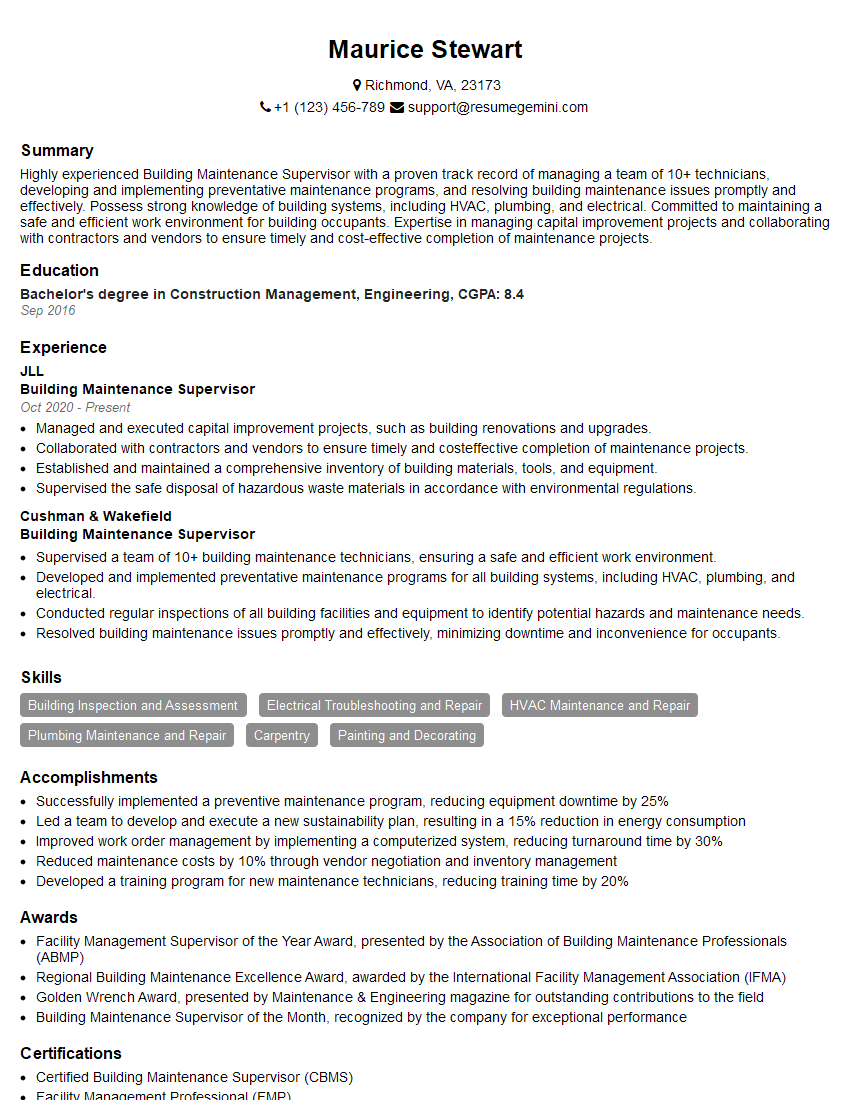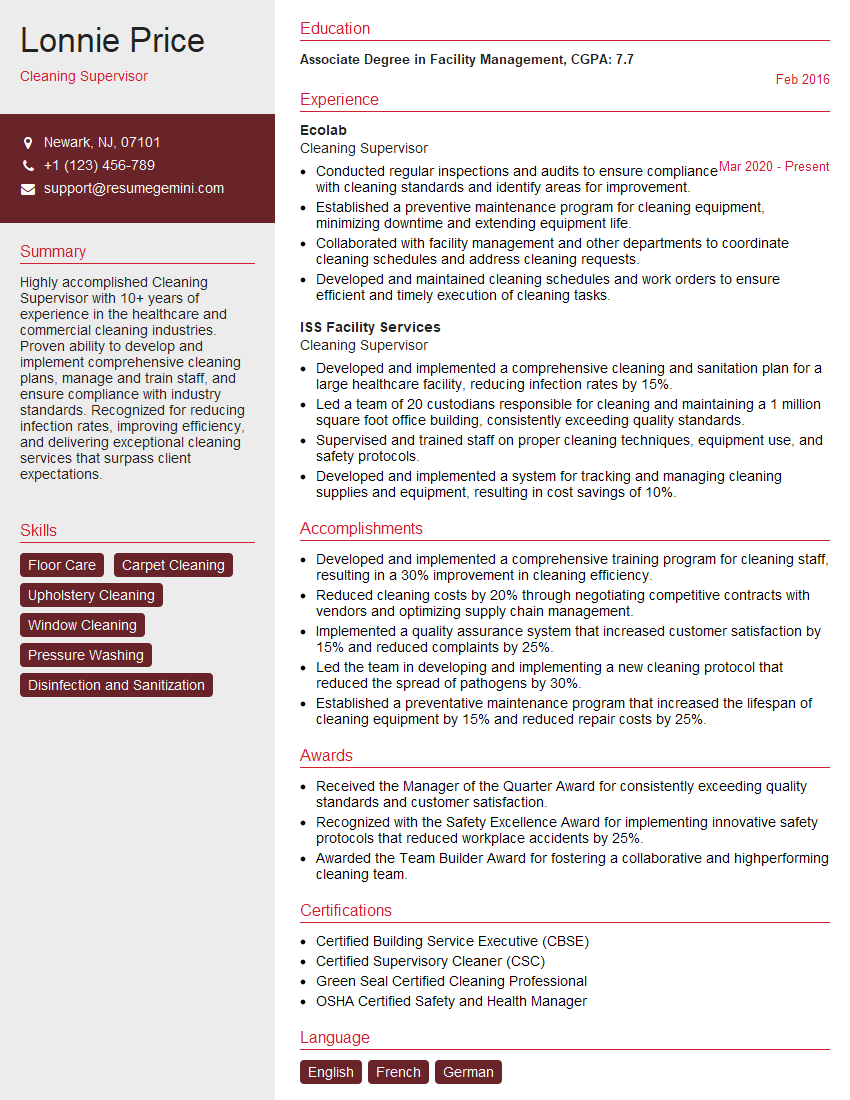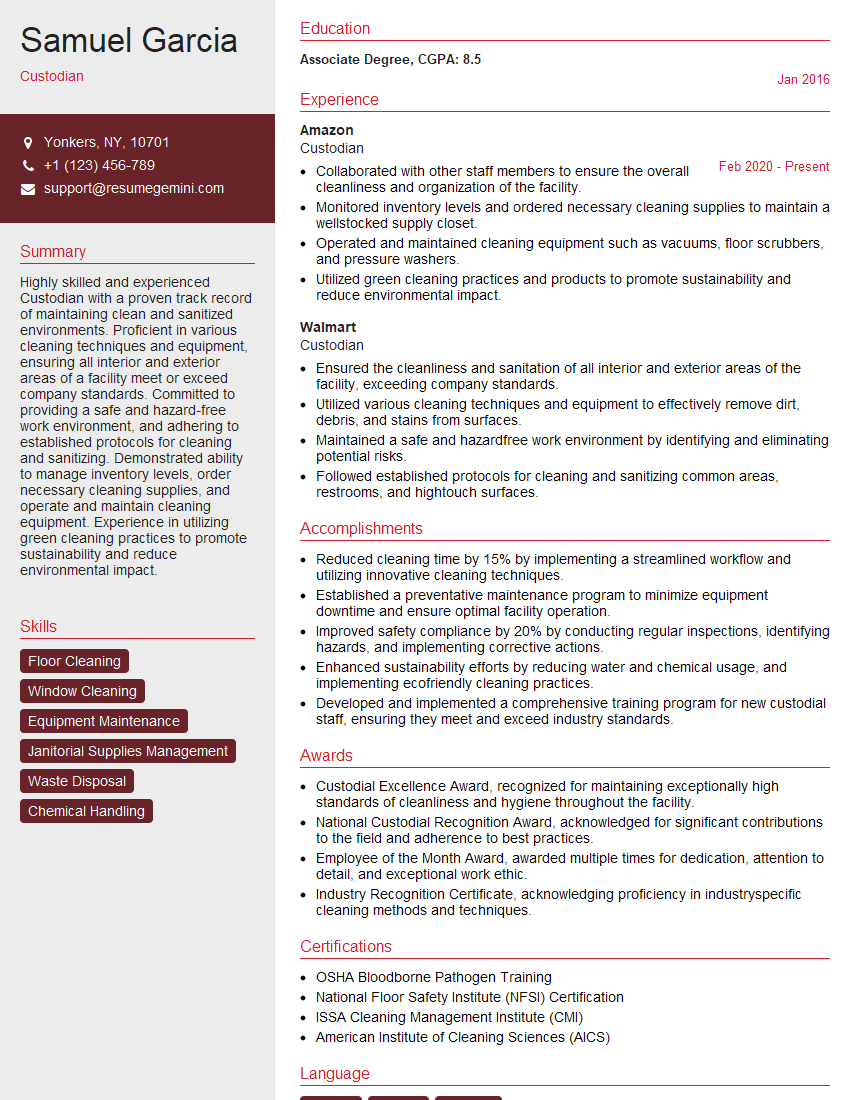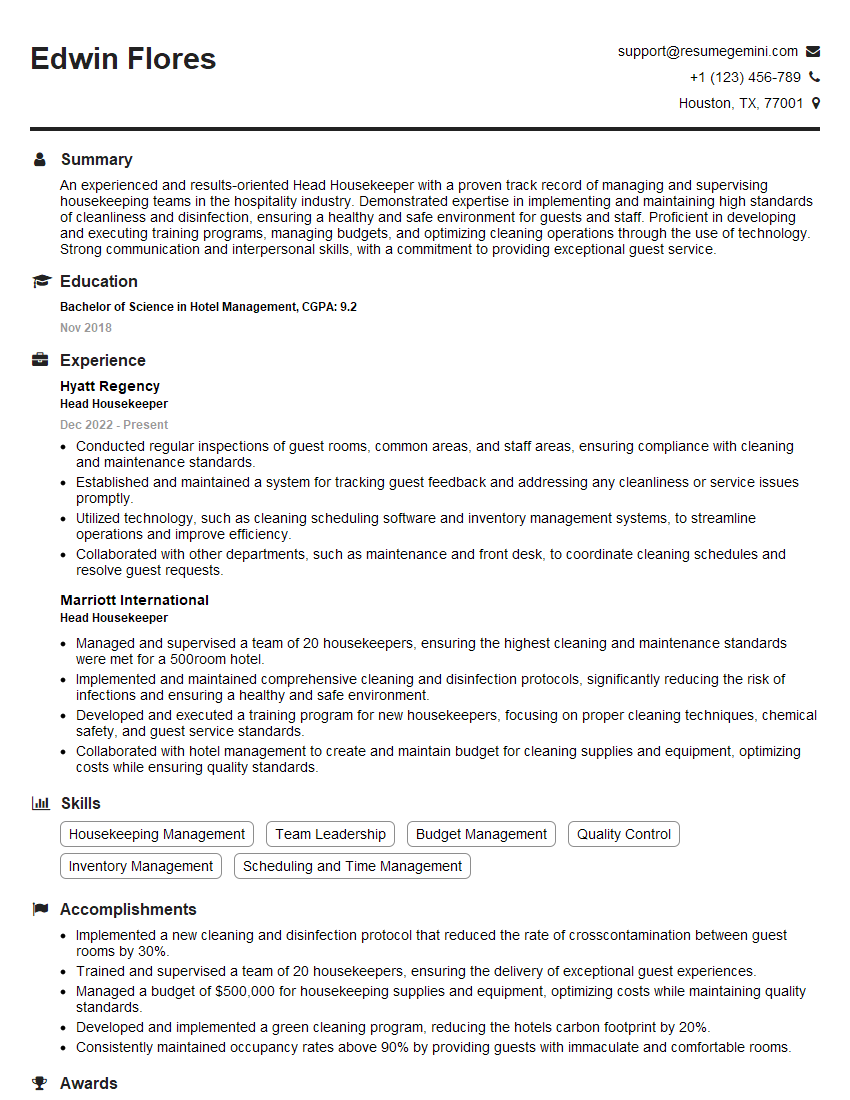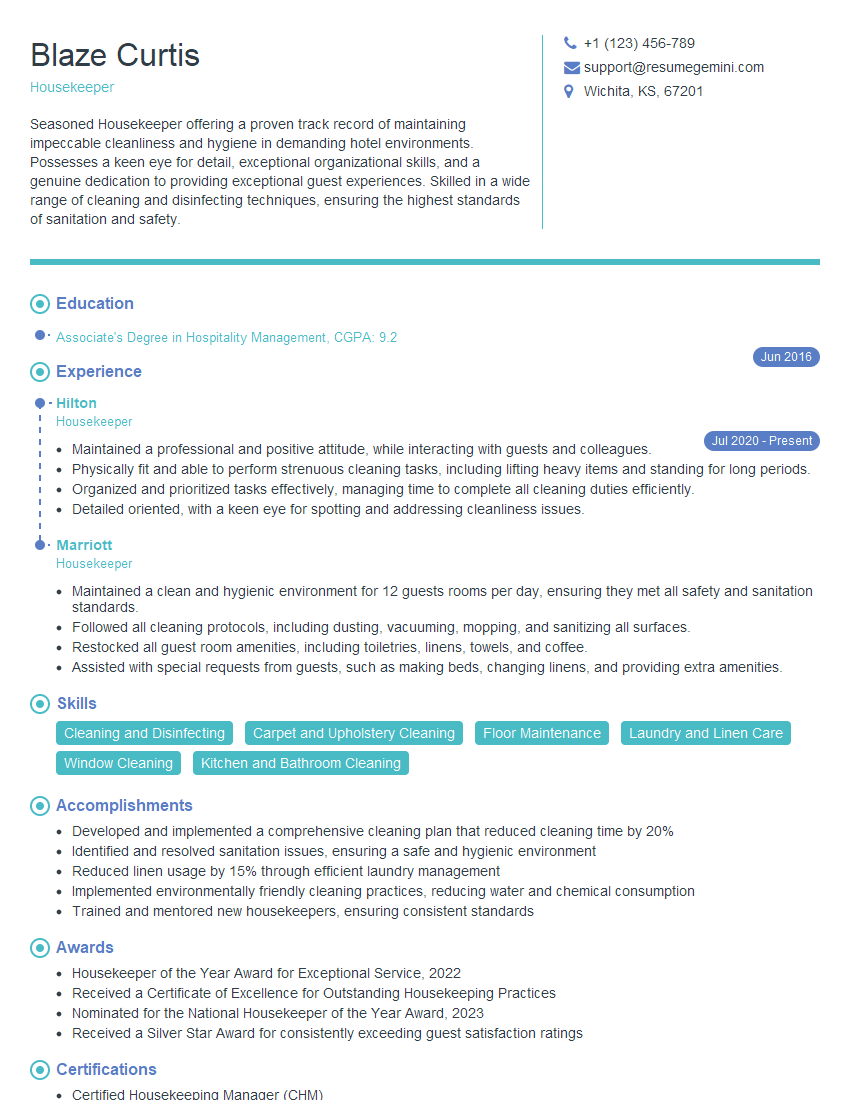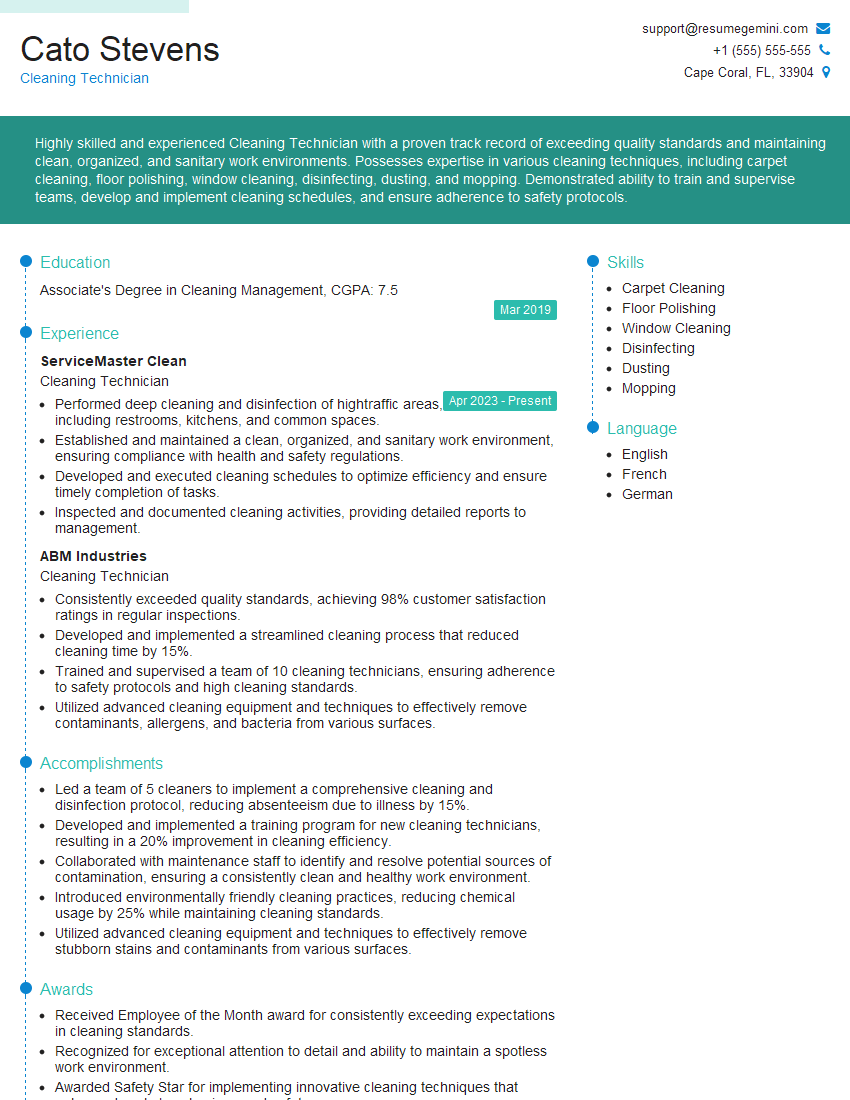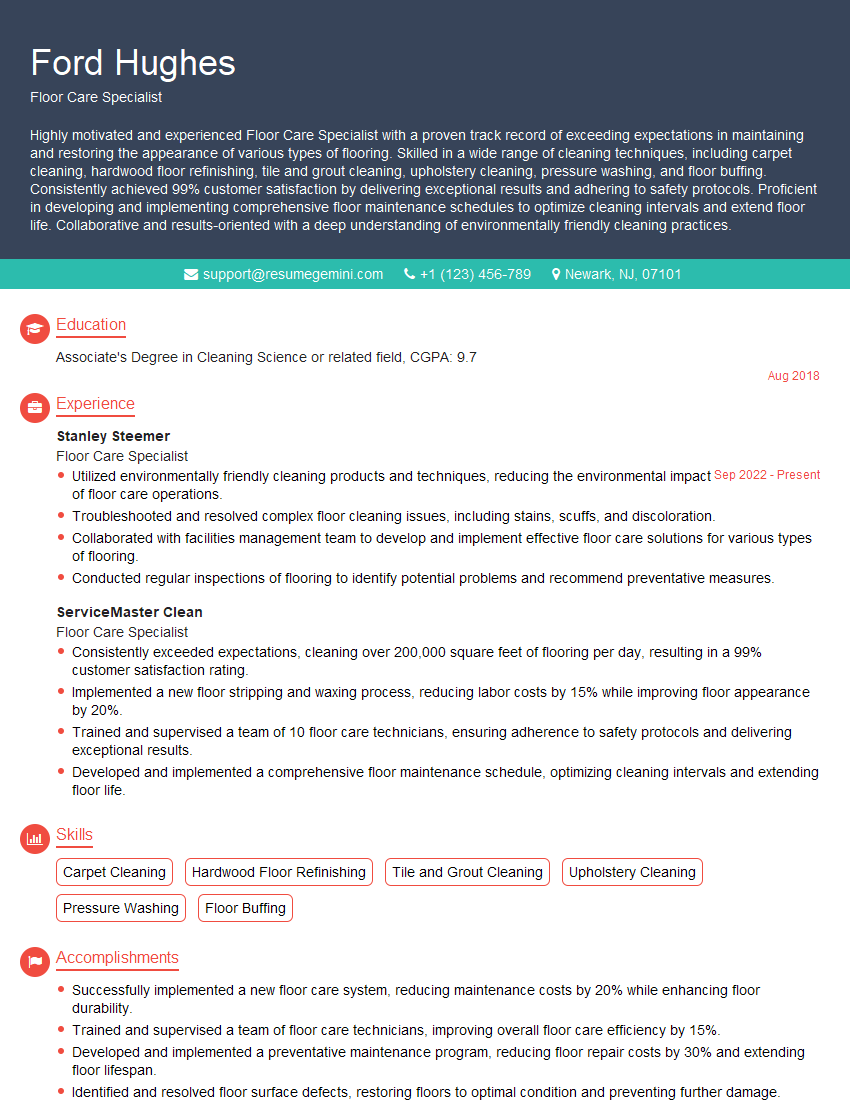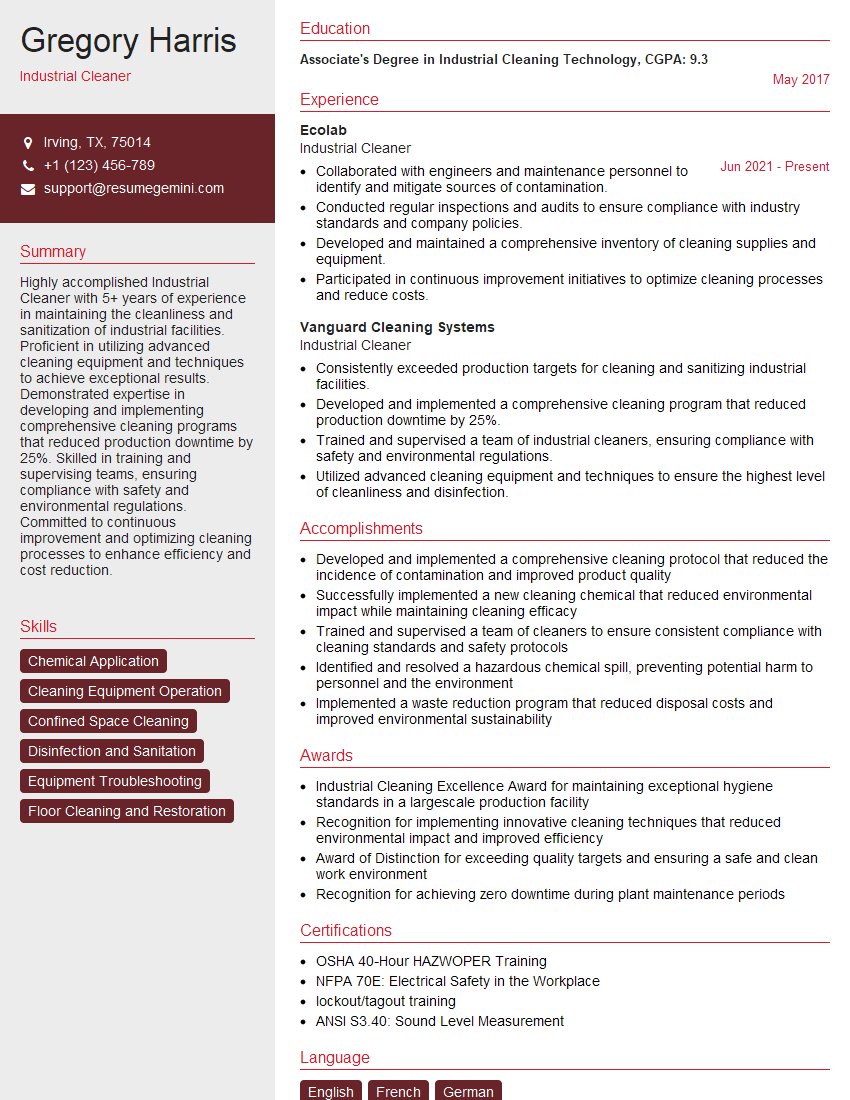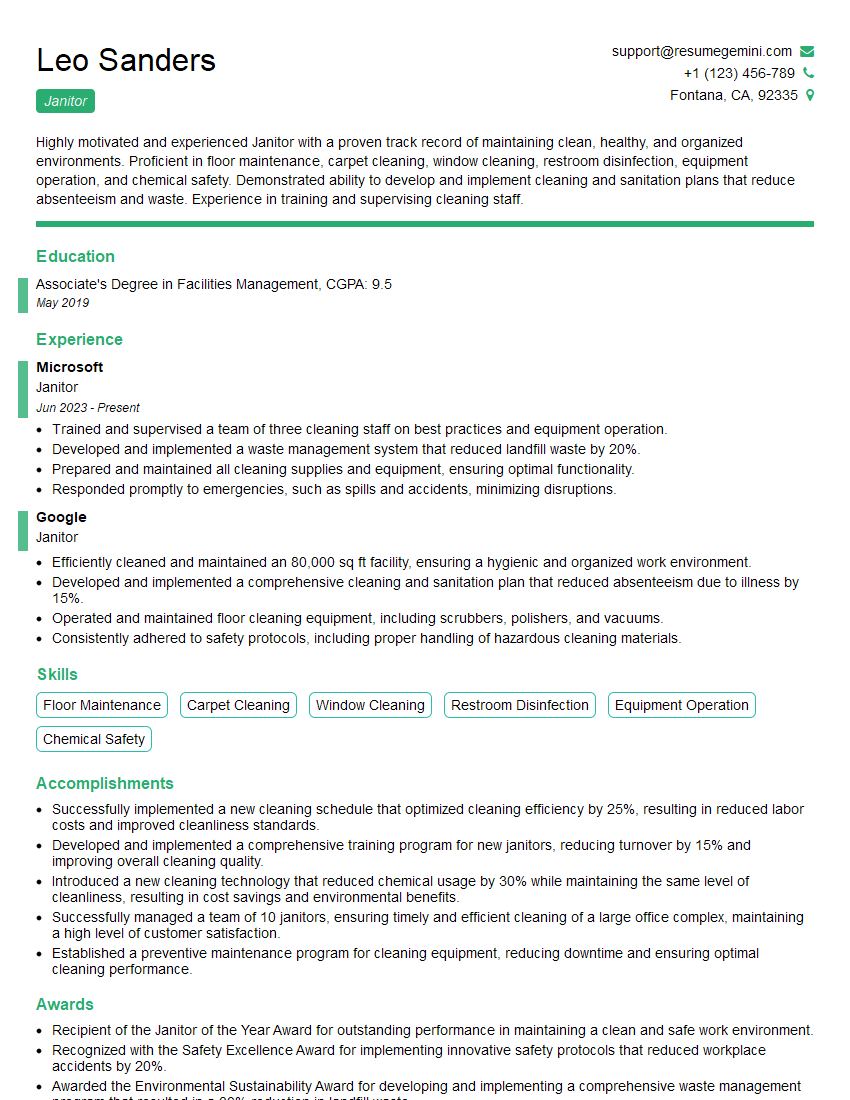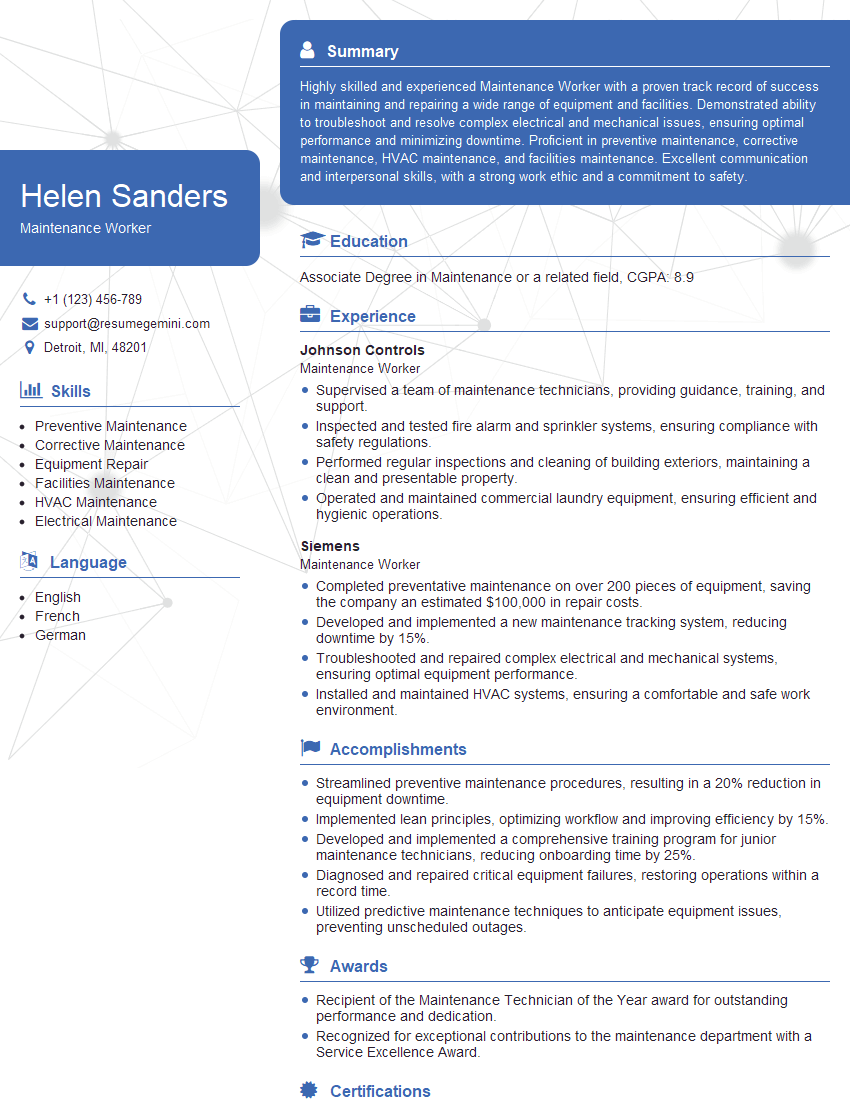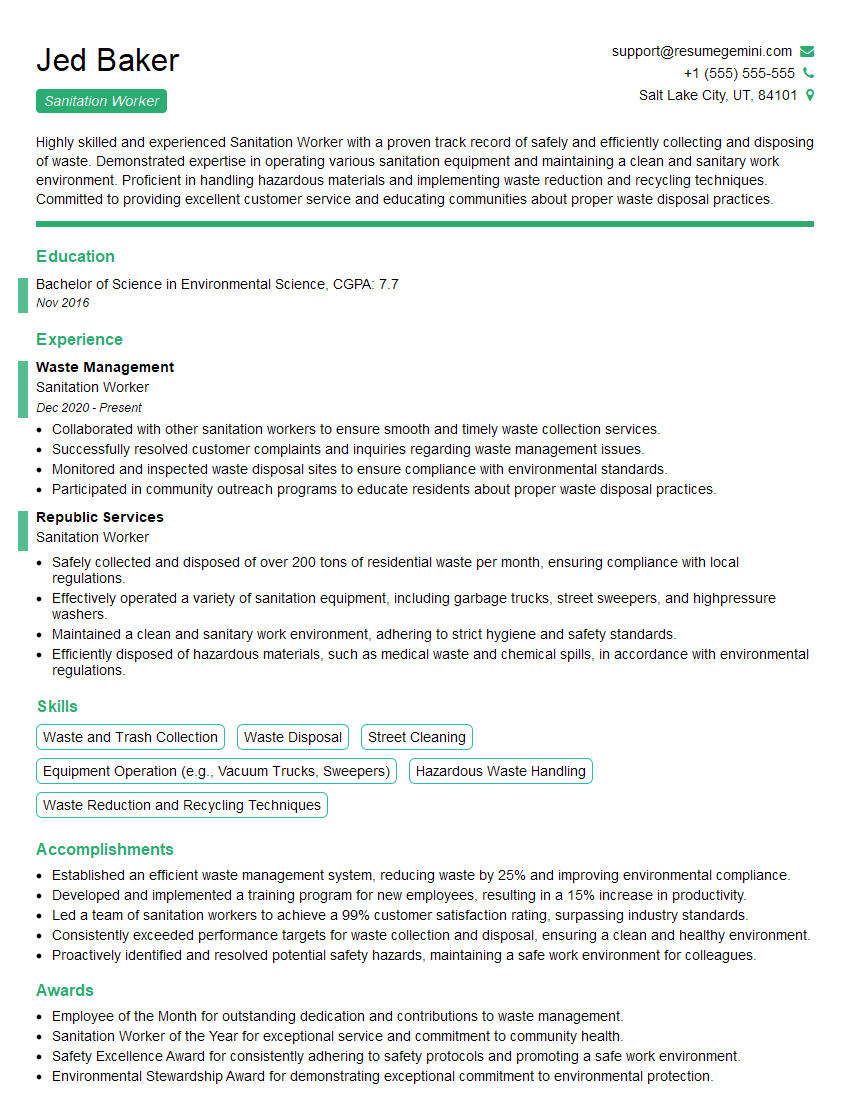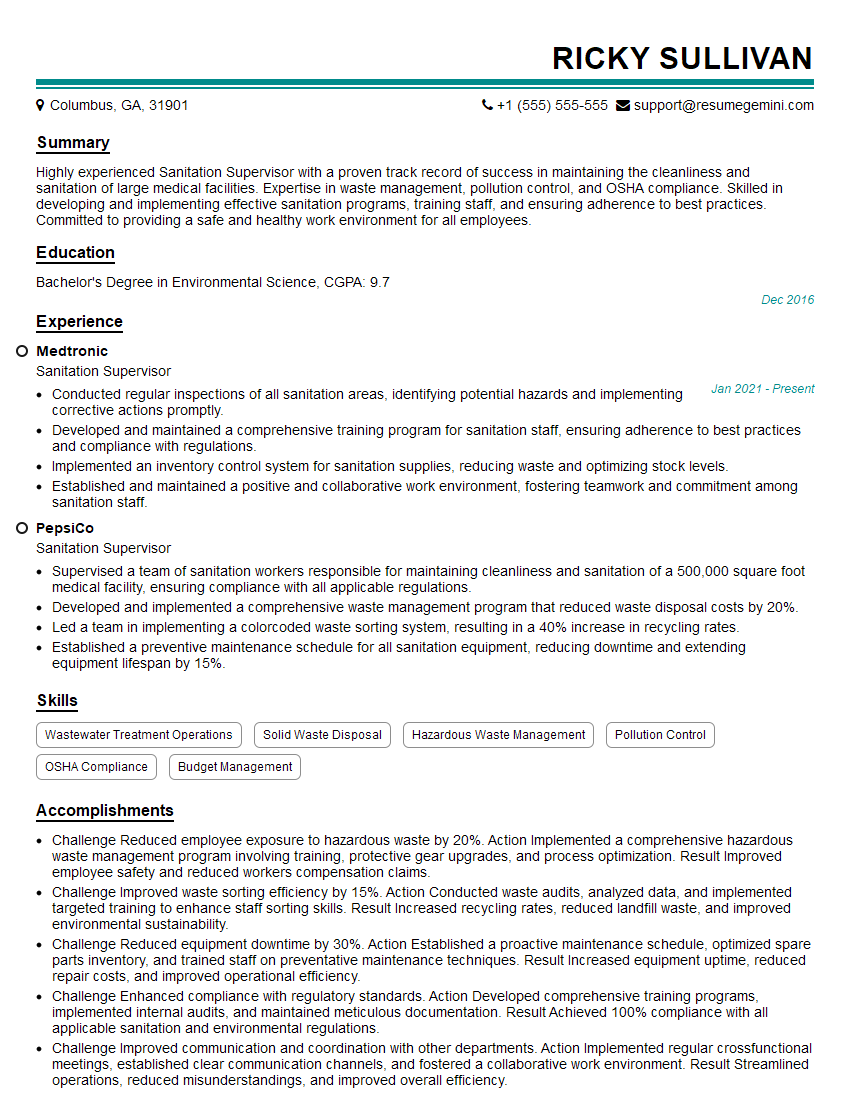Interviews are more than just a Q&A session—they’re a chance to prove your worth. This blog dives into essential Mop Application interview questions and expert tips to help you align your answers with what hiring managers are looking for. Start preparing to shine!
Questions Asked in Mop Application Interview
Q 1. What types of mops are you familiar with?
I’m familiar with a variety of mop types, each suited for different flooring and cleaning tasks. These include:
- String mops: These classic mops are cost-effective and great for general cleaning on most hard floors. They’re effective at absorbing liquids, but require more rinsing to avoid spreading dirt.
- Sponge mops: Offering a good balance of absorbency and durability, sponge mops are versatile and suitable for both wet and dry cleaning. They are often preferred for larger areas due to their efficiency.
- Microfiber mops: Known for their exceptional cleaning power, microfiber mops attract and trap dirt and dust effectively, often requiring less cleaning solution. They’re ideal for all hard floor types and are excellent at removing stubborn stains.
- Flat mops (with reusable or disposable pads): These offer excellent maneuverability and are easy to wring out, making them suitable for various flooring types. The ease of replacing pads allows for quick sanitation between rooms.
- Spin mops: These mops have a built-in mechanism for easy wringing, minimizing contact with dirty water. They’re great for those who prefer less physical exertion during cleaning.
The choice of mop depends on the floor type, the size of the area, the type of soil, and personal preference.
Q 2. Describe your process for preparing a mop for use.
Preparing a mop involves several crucial steps to ensure effective and hygienic cleaning. My process is as follows:
- Inspect the mop: Check for any damage, loose fibers, or lingering dirt from previous use. Replace worn-out mops promptly.
- Rinse thoroughly: Rinse the mop head under running water until the water runs clear. This removes any residual cleaning solution or dirt.
- Prepare the cleaning solution: Depending on the mop type and the floor’s condition, mix the appropriate cleaning solution following the manufacturer’s instructions. For routine cleaning, a mild solution of water and a suitable floor cleaner is usually sufficient. Remember to test your solution in an inconspicuous area first.
- Attach the mop head (if applicable): Secure the mop head correctly to ensure efficient cleaning and prevent it from detaching mid-clean.
- Pre-wet the mop (optional): For some floor types and cleaning solutions, pre-wetting the mop can enhance the cleaning process.
Remember to always use clean water and the correct cleaning solution for your mop and floor type to avoid damage or streaks.
Q 3. How do you determine the appropriate amount of cleaning solution to use?
Determining the appropriate amount of cleaning solution depends on several factors:
- Type of floor: Different floor types require different cleaning solutions and concentrations. For example, hardwood floors may require less cleaning solution than tile floors.
- Level of soiling: Heavily soiled areas might require a more concentrated cleaning solution or a more frequent cleaning cycle.
- Manufacturer’s instructions: Always follow the manufacturer’s recommendations for both the cleaning solution and the mop.
- Water hardness: Hard water can affect the cleaning solution’s effectiveness; using distilled or softened water can improve the results.
As a rule of thumb, it’s better to start with a diluted solution and increase the concentration only if necessary. It’s always preferable to avoid over-saturating the floor, as this can lead to damage or residue.
Q 4. Explain your method for mopping a large floor area efficiently.
Efficiently mopping a large floor area involves a systematic approach. I typically use the following method:
- Divide and conquer: Divide the area into smaller, manageable sections. This prevents overlapping and ensures thorough cleaning.
- Work systematically: Mop in straight lines or patterns, overlapping each stroke slightly to prevent missed spots. Working from the furthest point towards the exit ensures you don’t walk through already-cleaned areas.
- Rinse frequently: Rinse the mop head frequently in clean water to avoid spreading dirt and grime. A bucket with clean water for rinsing and a separate bucket for dirty water is highly recommended.
- Use appropriate technique: Employ light pressure to avoid damaging the floor and use the full surface area of the mop for even cleaning.
- Employ a partner (if possible): For extremely large areas, having a partner can significantly increase efficiency, one person mopping while the other rinses and prepares fresh solution.
This approach ensures thorough cleaning while minimizing effort and time.
Q 5. How do you handle spills or difficult stains during mopping?
Handling spills and stains requires immediate attention and a slightly different approach:
- Address the spill immediately: Act quickly to prevent the spill from spreading and setting.
- Absorb excess liquid: Use clean cloths or paper towels to absorb as much liquid as possible before mopping.
- Pre-treat stubborn stains: Apply a suitable stain remover, following the product instructions. Allow the stain remover to dwell for the recommended time before mopping.
- Use a clean mop head: Use a clean section of the mop or a fresh mop head to avoid spreading the stain.
- Rinse thoroughly: Thoroughly rinse the area after cleaning to remove any residue from the stain remover.
For particularly stubborn stains, a more targeted approach using appropriate cleaning agents may be required.
Q 6. What is your procedure for cleaning and storing mops after use?
Cleaning and storing mops properly is crucial for hygiene and mop longevity:
- Rinse thoroughly: Rinse the mop head thoroughly under running water until all dirt and cleaning solution are removed.
- Clean the mop handle: Wipe down the mop handle with a disinfectant cleaner.
- Air dry: Allow the mop head to air dry completely before storing to prevent mold and mildew growth.
- Store properly: Store the mop in a clean, dry place, ideally in a well-ventilated area. Avoid storing mops in damp or enclosed spaces.
- Regular deep cleaning: Periodically deep clean your mops, which can include washing in a washing machine (following manufacturer instructions) or soaking in a disinfectant solution.
Proper cleaning and storage will extend the life of your mops and maintain hygiene standards.
Q 7. What safety precautions do you take while mopping?
Safety is paramount when mopping. Here are some crucial precautions:
- Use caution on wet floors: Wet floors are extremely slippery. Place warning signs if necessary and walk carefully.
- Use appropriate footwear: Wear non-slip shoes or footwear with good traction to minimize the risk of falls.
- Avoid overfilling buckets: Overfilling buckets increases the risk of spills and accidents.
- Use appropriate cleaning solutions: Use cleaning solutions that are appropriate for the floor type and follow all safety instructions on the product label. Wear gloves if necessary.
- Proper ventilation: Ensure adequate ventilation to avoid inhaling excessive cleaning solution fumes.
- Be mindful of electrical hazards: Avoid using electrical appliances near wet areas.
Prioritizing safety prevents accidents and ensures a safe working environment.
Q 8. How do you handle different types of flooring (tile, wood, etc.) when mopping?
Handling different flooring types during mopping requires a tailored approach to prevent damage and ensure effective cleaning. Think of it like choosing the right tool for the job – you wouldn’t use a hammer to screw in a screw!
- Tile: Tile is generally durable and can tolerate more water. I use a slightly damp mop and a cleaning solution appropriate for tile, focusing on removing grout grime. For stubborn stains, I might pre-treat them with a specialized tile cleaner before mopping.
- Wood: Wood floors are more delicate. I use a minimally damp mop, almost just a damp cloth, to avoid water damage. I avoid harsh chemicals and opt for wood-specific cleaners. I always ensure the floor is completely dry after mopping to prevent warping or staining.
- Laminate: Similar to wood, laminate is susceptible to water damage. I use the same minimally damp mop technique and avoid harsh chemicals. I work in smaller sections, ensuring each area is dry before moving on.
- Other surfaces (e.g., marble, stone): Each surface requires research into its specific cleaning needs. Some may be sensitive to certain chemicals or require specialized cleaning techniques. Always check manufacturer recommendations before cleaning.
The key is to always test a cleaning solution on an inconspicuous area first to ensure it doesn’t damage the surface.
Q 9. Describe your experience with various cleaning solutions and their appropriate uses.
My experience encompasses a wide range of cleaning solutions, each suited for specific purposes and flooring types. Just like a chef chooses the right spice for a dish, the right cleaning solution is crucial for effective and safe cleaning.
- All-purpose cleaners: Great for general cleaning on most hard surfaces, but I avoid them on delicate wood or stone floors. I dilute them according to the manufacturer’s instructions to prevent damage.
- Disinfectant cleaners: Essential for high-traffic areas or spaces needing sterilization. I always follow safety precautions and ensure proper ventilation when using them.
- Wood floor cleaners: Specially formulated to clean and condition wood floors without causing damage. These are a must-have for preserving the longevity and beauty of wood flooring.
- Tile and grout cleaners: Effective for removing stubborn stains and grime from tile grout. I often use these for a deeper clean in kitchens and bathrooms.
- Natural cleaners (e.g., vinegar and water): A cost-effective and environmentally friendly option for general cleaning, particularly on less soiled areas.
I always carefully read and follow the instructions on cleaning solution labels. Safety is paramount.
Q 10. How do you ensure the mop is adequately wrung out to prevent excess water?
Adequately wringing out a mop is critical to prevent excess water, which can damage floors and lead to longer drying times. Think of it like squeezing a sponge – you don’t want it dripping wet.
My process involves:
- Using a mop bucket with a wringer system: This provides a consistent and effective way to remove excess water.
- Wringing the mop thoroughly: I ensure the mop is squeezed firmly, removing as much water as possible without making it completely dry.
- Testing the mop on a less visible area: Before continuing, I test the dampness of the mop on a small, inconspicuous area to ensure it’s not leaving too much water behind.
- Rinsing and repeating: I rinse the mop frequently during the mopping process to remove accumulated dirt and grime and repeat the wringing process to maintain optimal dampness.
Over time, I’ve learned the optimal level of dampness for different floor types, ensuring efficient cleaning without causing any damage.
Q 11. What is your process for mopping in high-traffic areas?
High-traffic areas require a more thorough and frequent cleaning approach. Think of it like tending to a busy garden – it needs more attention than a quiet corner.
My process involves:
- Pre-cleaning: I start by removing any loose debris or dirt with a broom or vacuum cleaner.
- Sectioning: I divide the area into smaller, manageable sections to avoid overlapping wet areas.
- Thorough cleaning: I pay extra attention to high-traffic zones, perhaps using a slightly more vigorous cleaning action, but always taking care not to damage the flooring.
- Multiple passes: I often make multiple passes over these areas to ensure all dirt and grime are removed.
- Faster drying: I might use a clean, dry cloth or towel to quickly dry the high-traffic areas after mopping, to prevent re-soiling.
Regular, more frequent cleaning in these areas prevents the build-up of dirt and helps maintain a consistently clean appearance.
Q 12. How do you deal with difficult-to-reach areas during mopping?
Difficult-to-reach areas, such as corners and under furniture, require specialized techniques. Think of it as a puzzle – you need to find the right pieces to complete the picture.
My strategies include:
- Using a smaller mop head: A smaller mop head allows for better access to tight spaces and corners.
- Employing cleaning tools: I use scrub brushes, microfiber cloths, and even cotton swabs to clean hard-to-reach areas effectively.
- Moving furniture (with caution): Where possible, and with care, I move smaller items of furniture to clean underneath.
- Using extension handles: Using mops with extension handles reaches areas high up without needing a ladder.
Safety is always my priority. I never attempt to reach for areas that would require unsafe maneuvering.
Q 13. Describe a time you had to improvise a cleaning solution or method.
Once, I ran out of wood floor cleaner during a large cleaning job. Rather than postpone, I improvised using a mixture of warm water, a small amount of white vinegar, and a drop of mild dish soap. I tested the mixture on an inconspicuous area first. This solution worked surprisingly well, effectively cleaning the floors without leaving any streaks or damage. This experience highlighted the importance of resourcefulness and careful testing before applying any cleaning solution.
Q 14. How do you maintain the cleanliness and hygiene of your mopping equipment?
Maintaining the cleanliness and hygiene of my mopping equipment is crucial to prevent the spread of germs and ensure effective cleaning. Think of it like maintaining a sharp knife – you wouldn’t use a dull knife for precise cutting.
My process involves:
- Rinsing thoroughly after each use: I always rinse the mop head and bucket thoroughly to remove any remaining dirt and cleaning solution.
- Regular washing: Mop heads are regularly laundered in hot water with detergent. I allow them to completely air dry before reuse to prevent mildew growth.
- Bucket cleaning: The bucket is cleaned with hot soapy water and disinfected regularly to prevent bacteria build-up.
- Regular inspection and replacement: I regularly inspect the mop for wear and tear and replace it when necessary to maintain effectiveness.
Maintaining clean equipment ensures hygienic cleaning and prolongs the lifespan of my supplies.
Q 15. What are the signs of a poorly maintained mop or cleaning solution?
A poorly maintained mop or cleaning solution manifests in several ways. Think of it like this: your mop is your tool, and the solution is its fuel. If either is compromised, the entire cleaning process suffers.
- For the mop: A frayed, smelly mop head indicates inadequate rinsing and drying, leading to bacterial growth and reduced cleaning efficiency. A warped or broken mop handle shows wear and tear from improper use or storage. A stiff, inflexible mop head might be overly saturated with a cleaning agent, making it less effective.
- For the cleaning solution: A cloudy or discolored solution suggests contamination or improper mixing. An overly strong or weak solution will compromise cleaning power – too strong and you risk damage to surfaces, too weak and you’re just spreading dirt around. A solution with a foul odor implies bacterial contamination.
Imagine trying to paint a wall with a worn-out brush and diluted paint – the result would be patchy and unsatisfactory. The same principle applies to mopping. Regular inspection and maintenance are vital.
Career Expert Tips:
- Ace those interviews! Prepare effectively by reviewing the Top 50 Most Common Interview Questions on ResumeGemini.
- Navigate your job search with confidence! Explore a wide range of Career Tips on ResumeGemini. Learn about common challenges and recommendations to overcome them.
- Craft the perfect resume! Master the Art of Resume Writing with ResumeGemini’s guide. Showcase your unique qualifications and achievements effectively.
- Don’t miss out on holiday savings! Build your dream resume with ResumeGemini’s ATS optimized templates.
Q 16. How do you handle a situation where a mop head becomes damaged or soiled?
Dealing with a damaged or soiled mop head requires a systematic approach. First, assess the damage. Minor soiling can often be addressed by thorough rinsing and washing. If the soiling is significant or the head is physically damaged (rips, tears), replacement is necessary.
- Rinsing and Washing: Rinse the mop head thoroughly under hot, running water until the water runs clear. Then, wash it with a suitable detergent and hot water. Ensure you remove all traces of the cleaning solution and any residual dirt.
- Disinfection: For heavily soiled or potentially contaminated mop heads (e.g., cleaning up spills), immerse the mop head in a disinfecting solution according to manufacturer’s instructions, ensuring proper contact time.
- Drying: Allow the mop head to air dry completely before storing to prevent mold and mildew growth. Avoid storing it in a damp place. Proper drying is essential for extending the mop’s lifespan and maintaining hygiene.
- Replacement: If the mop head is irreparably damaged or excessively worn, replace it immediately with a fresh, clean one to maintain cleaning standards.
Think of this process like changing a tire on a car – you wouldn’t try to patch an irreparable tear; you’d replace the tire for safety and effectiveness. Replacing a damaged mop head ensures a thorough and hygienic clean each time.
Q 17. What are the differences between wet mopping and damp mopping?
The difference between wet and damp mopping lies primarily in the amount of cleaning solution used and the level of saturation of the mop head. This choice is heavily influenced by the surface being cleaned and the type of soiling.
- Wet Mopping: This involves using a generously saturated mop head with cleaning solution. It’s ideal for heavily soiled floors that require aggressive cleaning. It’s crucial to ensure proper drying to prevent water damage and potential slip hazards.
- Damp Mopping: This uses a lightly damp mop head with minimal cleaning solution. It’s perfect for routine cleaning of less soiled surfaces where a light clean is sufficient. Damp mopping minimizes the risk of water damage and reduces drying time.
Imagine cleaning a muddy boot: you’d use a lot of water (wet mopping) to get rid of the mud, but for a slightly dusty shoe, a damp cloth (damp mopping) would suffice.
Q 18. How do you ensure proper ventilation while mopping?
Ensuring proper ventilation while mopping is crucial to prevent the buildup of moisture and potentially harmful chemicals. Adequate ventilation reduces the risk of slip hazards, mold growth, and respiratory issues.
- Open windows and doors: Increase airflow by opening windows and doors, particularly in smaller spaces.
- Use fans: Circulate air using fans to accelerate the drying process and disperse moisture and cleaning solution fumes.
- Avoid mopping in enclosed spaces for extended periods: Minimize the time spent mopping in poorly ventilated spaces to reduce exposure to fumes.
- Monitor moisture levels: Keep an eye on moisture levels, particularly in areas prone to water damage.
Just as you’d open a window after showering to avoid condensation, good ventilation after mopping prevents similar issues.
Q 19. What are the best practices for disposing of cleaning solution and waste?
Proper disposal of cleaning solutions and waste is vital for environmental protection and worker safety. Never pour cleaning solutions down the drain without checking the product label for specific instructions.
- Cleaning Solution Disposal: Follow the manufacturer’s instructions for disposal. Some solutions can be diluted and safely flushed, while others require specialized disposal methods.
- Waste Disposal: Dispose of soiled mop heads according to your facility’s waste management protocols. This might involve designated waste bins for soiled cleaning materials.
- Recycling: If possible, recycle reusable components of the mop and its packaging.
- Hazardous Waste: For hazardous cleaning solutions, follow all applicable local, state, and federal regulations for safe disposal. This often involves contacting a hazardous waste disposal company.
Think of it like sorting your household recycling – proper disposal keeps the environment clean and prevents accidents.
Q 20. What are some common mistakes to avoid when mopping?
Common mistakes to avoid when mopping include:
- Over-saturating the mop head: This leads to excessive water, longer drying times, and potential water damage.
- Using the wrong cleaning solution: Employing the wrong type of cleaner for the surface can damage the flooring.
- Not rinsing the mop head frequently: This results in spreading dirt instead of cleaning.
- Ignoring safety precautions: Not using appropriate gloves and footwear can lead to skin irritation and slips.
- Improper storage: Storing a damp mop can breed bacteria and mold.
Imagine baking a cake: you wouldn’t throw all the ingredients in at once and hope for the best. Similarly, following a systematic mopping approach is essential.
Q 21. How do you prioritize mopping tasks in a busy environment?
Prioritizing mopping tasks in a busy environment demands a strategic approach. Think of it as managing a project with multiple deadlines.
- High-traffic areas first: Prioritize heavily trafficked areas such as entrances and hallways to maintain a clean and safe environment.
- High-risk areas: Address areas prone to spills or accidents promptly.
- Visible areas: Clean visible areas to create a good first impression.
- Time constraints: Consider time constraints and allocate tasks accordingly.
- Workflow: Establish a consistent workflow to ensure efficient cleaning.
Prioritizing tasks strategically ensures that the most important areas are cleaned first, ensuring efficiency and a clean working environment.
Q 22. What is your experience with different types of mop wringers?
My experience encompasses a wide range of mop wringers, from the traditional bucket-and-mop system to more advanced models. I’m proficient with various types, including:
- Bucket and Mop systems: These are the most basic, requiring manual wringing. Different bucket designs, such as those with separate compartments for clean and dirty water, impact efficiency.
- Centrifugal Spin Wringers: These use a spinning mechanism to extract water from the mop head, resulting in faster and more efficient wringing compared to manual methods. The spin speed often is adjustable, allowing control over mop dampness.
- Press Wringers: These utilize a clamping mechanism to squeeze excess water from the mop. They are generally easier on the hands than manual wringing but may not extract as much water as a centrifugal wringer.
- Flat Mop Systems with built-in wringing systems: These often include a system that allows for quick and easy wringing using a pedal or lever, often integrated with a cleaning solution dispensing system.
My expertise extends to understanding the pros and cons of each type and choosing the most appropriate one based on the specific cleaning task, floor type, and available resources. For instance, a centrifugal wringer is ideal for large areas with heavy soil, while a press wringer might be more suitable for delicate floors.
Q 23. How do you identify and address safety hazards related to mopping?
Safety is paramount during mopping. I identify hazards proactively by conducting a thorough pre-cleaning inspection. This includes looking for:
- Spills: Any spills – whether liquid or granular – must be addressed immediately. I’d start by cleaning up the spill before any mopping to prevent it from spreading.
- Uneven flooring: Loose floor tiles, raised edges, or other uneven surfaces are tripping hazards that need attention. I’d use caution and perhaps even temporarily cordon off these areas.
- Obstacles: Electrical cords, furniture, etc. I’d make sure to move obstacles or clean around them carefully.
- Wet floor signage: Always using appropriate signage and ensuring proper warning visibility for others to prevent accidents.
I address these by implementing solutions like using appropriate cleaning equipment (e.g., avoiding excessively long mop handles for better control), working methodically (to avoid spills and splashing), and always communicating my presence to others.
Q 24. What is your approach to training new team members on proper mopping techniques?
Training new team members involves a three-step process:
- Demonstration: I demonstrate the proper techniques—from preparing the cleaning solution to the mopping motions and proper wringing—using a step-by-step approach. I focus on correct posture to prevent back injuries.
- Hands-on Practice: New team members practice under my supervision. I provide feedback, correcting any improper techniques and ensuring they understand the importance of even strokes and proper water control to prevent streaks or excessive wetness.
- Assessment: Finally, I assess their skills, ensuring they’re comfortable and proficient before allowing them to mop independently.
I use a combination of visual aids, such as diagrams, and practical exercises to ensure comprehension. I emphasize the importance of consistency and adherence to the established cleaning protocols.
Q 25. How do you maintain consistency in cleaning standards during mopping tasks?
Maintaining consistent cleaning standards requires a structured approach:
- Checklists: I utilize detailed checklists to ensure all areas are cleaned thoroughly and consistently, according to the defined procedures. This covers everything from the amount of cleaning solution used to the appropriate rinsing techniques.
- Regular Inspections: Regular inspections of cleaned areas help identify inconsistencies and areas needing improvement. I often perform spot-checks throughout the day and a final check upon completion.
- Standardized Procedures: Clearly defined cleaning procedures, communicated to all team members, are critical for consistency. This includes methods for handling different floor types and soil.
- Feedback and Training: Regular feedback and additional training for team members are used to maintain skills and address any variations.
By combining these practices, we ensure everyone understands the standards and works towards achieving them consistently.
Q 26. How do you adapt your mopping techniques based on the type of soil or mess?
Adapting mopping techniques to different soils is crucial for effective cleaning. For example:
- Sticky spills (e.g., juice, syrup): These require pre-treatment with a suitable cleaning solution before mopping to loosen the residue.
- Heavy soil (e.g., mud, dirt): I might pre-sweep or vacuum the area, then use a two-bucket system for efficient cleaning and preventing re-soiling.
- Grease: A degreasing solution is necessary for effective removal, followed by thorough rinsing and possibly multiple passes with the mop.
- Delicate floors: More gentle mopping techniques with less pressure and a damp, rather than wet, mop are necessary to avoid damage.
My approach involves choosing the correct cleaning solution and adjusting the mopping technique (pressure, number of passes, type of mop) to suit the specific soil. Using the right tools and products is critical in tackling diverse messes effectively and safely.
Q 27. What are some time-saving techniques you use when mopping?
Time-saving techniques are a priority. I implement strategies like:
- Efficient Zoning: Dividing the area into manageable zones prevents overlapping and wasted movement.
- Strategic Wetting: Only wetting the required area instead of the entire floor at once reduces the drying time and minimizes the risk of slipping hazards.
- Proper Water Management: Using the right amount of cleaning solution and changing the water frequently improves cleaning efficiency.
- Using appropriate tools: Choosing the right type of mop and wringer improves efficiency and reduces strain.
By efficiently organizing my workflow and using time-saving techniques, I can complete mopping tasks quickly without compromising the quality of cleaning.
Q 28. How do you ensure the safety of others while performing mopping duties?
Ensuring the safety of others while mopping involves:
- Clear Communication: I verbally warn people of wet floors, especially in high-traffic areas.
- Wet Floor Signs: Using highly visible wet floor signs around the cleaning area is essential.
- Cones or Barriers: In larger areas or during extensive cleaning, I may use cones or barriers to restrict access.
- Working methodically: Maintaining a controlled and organized approach prevents accidents due to carelessness.
My constant awareness of my surroundings and proactive communication prevent accidents, ensuring a safe environment for everyone.
Key Topics to Learn for Mop Application Interview
- Core Functionality: Understand the fundamental operations of the Mop Application, including its primary features and user interface.
- Data Management: Explore how data is handled within the application, focusing on data structures, storage, and retrieval methods.
- Workflow and Processes: Familiarize yourself with the typical workflows and processes involved in using the Mop Application, including common use cases and scenarios.
- Integration with Other Systems: Learn about how the Mop Application interacts with other systems or platforms, and the implications of these integrations.
- Problem-Solving and Troubleshooting: Practice identifying and resolving common issues or errors encountered while using the Mop Application. Develop your approach to debugging and problem-solving.
- Security Considerations: Understand the security features and best practices associated with the Mop Application, including data protection and access control.
- Performance Optimization: Explore techniques for optimizing the performance and efficiency of the Mop Application, such as identifying and resolving bottlenecks.
- Advanced Features (if applicable): If the Mop Application has advanced features, be prepared to discuss them and their practical applications.
Next Steps
Mastering Mop Application significantly enhances your marketability and opens doors to exciting career opportunities in [mention relevant industry/field]. To maximize your chances of landing your dream job, it’s crucial to create a compelling, ATS-friendly resume that showcases your skills and experience effectively. ResumeGemini is a trusted resource to help you build a professional and impactful resume. We provide examples of resumes tailored to Mop Application to guide you in creating a document that highlights your relevant expertise. Use these examples as a springboard to craft a resume that stands out from the competition and lands you that interview.
Explore more articles
Users Rating of Our Blogs
Share Your Experience
We value your feedback! Please rate our content and share your thoughts (optional).
What Readers Say About Our Blog
This was kind of a unique content I found around the specialized skills. Very helpful questions and good detailed answers.
Very Helpful blog, thank you Interviewgemini team.

